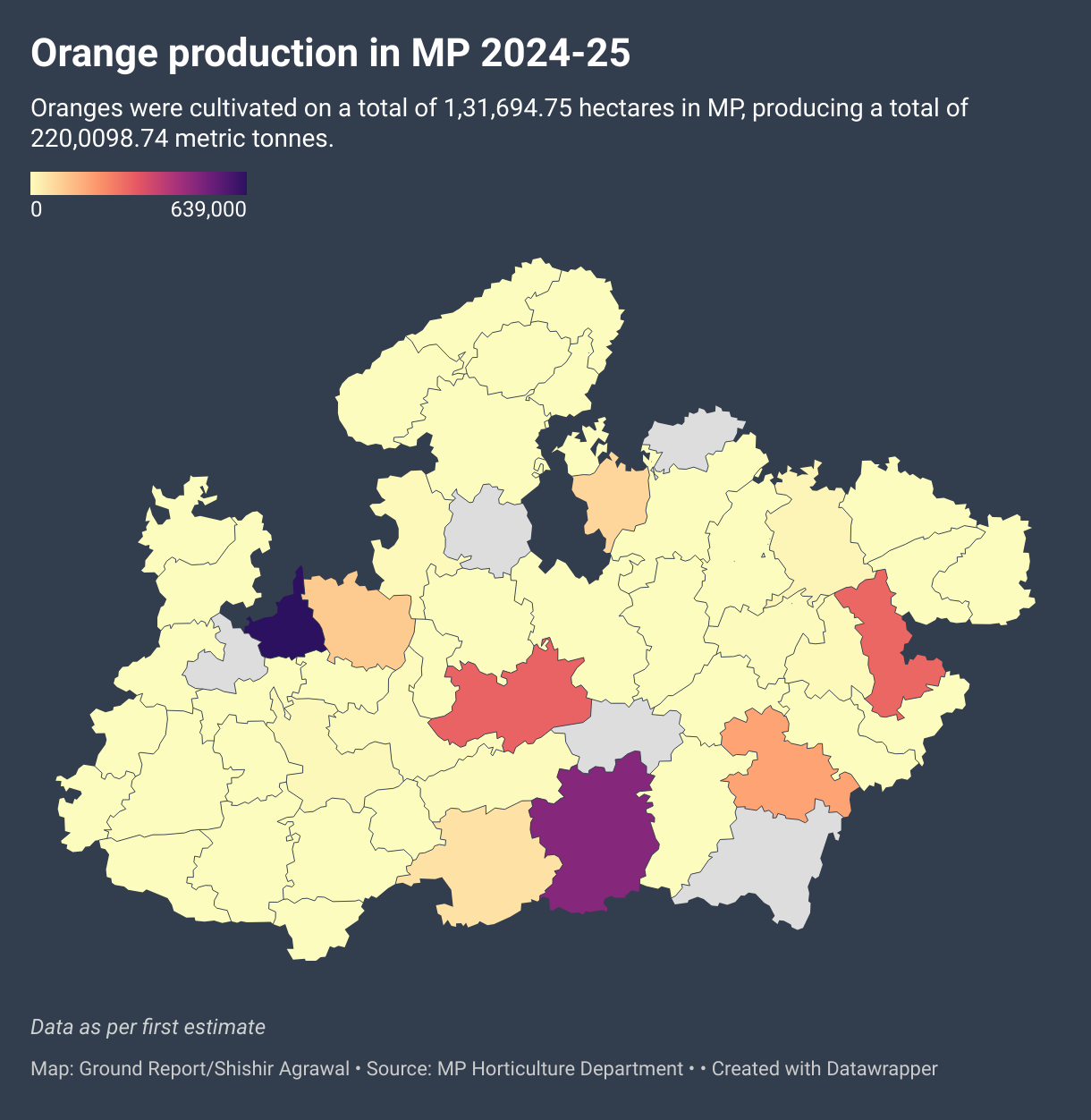Editor’s Note: This story includes references to suicide
On March 17, 2024, Chatakwar’s 3-acre orange orchard crop was nearly ripe. He had struck a deal with a local trader for ₹5 lakh, with the harvest scheduled for two days later. However, a sudden storm and heavy rain devastated his crop.
“I was expecting a yield of 15 tonnes of oranges last year,” Chatakwar laments. “But the rain poured for over two hours, destroying everything.”
In the end, he managed to salvage less than a tonne from his 700 trees.
Pandhurna district of Madhya Pradesh, 88 km away from Nagpur, also known as Orange City, is famous for its orange production. Earlier it used to be a part of Chhindwara district, but in 2023 it was separated and became a new district.
As soon as you enter Pandhurna from Bhopal, large orange orchards are visible. This fruit is the basis of the economy of this area. But in the last few years, this fruit has been badly hit by the weather. It has affected every section associated with this trade along with the farmers.
Globally, India is the fifth largest country in the world in terms of production of citrus fruits. According to the World Atlas, India produces 6,286,000 million tonnes of citrus fruits. But it also includes fruits like lemon and sweet lime. Nagpuri oranges, or mandarin oranges (Citrus reticulata), account for 40% of India’s total citrus cultivation.
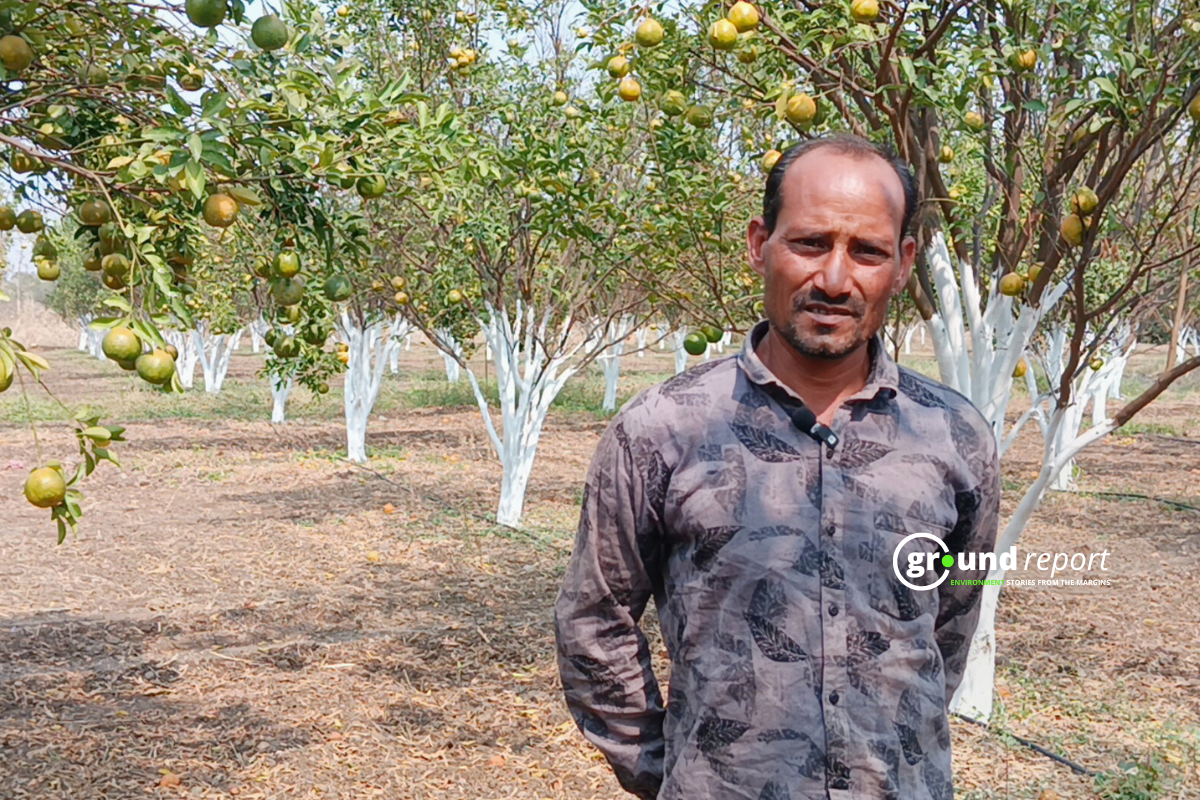
Orange Production in Madhya Pradesh
Madhya Pradesh is the top orange-producing state in the country. It produces 30% of India’s oranges. According to the first estimate for 2024-25, oranges were cultivated on a total of 1,31,694.75 hectares in Madhya Pradesh, producing a total of 220,0098.74 metric tonnes. The highest production of oranges in Madhya Pradesh is in the Agar Malwa district.
While Chhindwara district is in second place in this case. Last year, 4,90,000 metric tonnes of oranges were produced in 24,563 hectares here. Presently, there are 2 blocks in Pandhurna district, Pandhurna and Saunsar. These two blocks produce 2,50,500 and 15,5000 metric tonnes of oranges respectively.
Chatakwar’s story reflects a growing crisis in India’s orange belt, where erratic weather—driven by climate change—has made farming increasingly uncertain. Despite official data showing stable production, farmers and traders alike struggle with unpredictable yields, mounting losses, and shifting agricultural practices. As climate shocks continue to reshape the landscape, the future of Pandhurna’s orange economy hangs in the balance.
Orange farmer Vinod Jumde from Tigaon village in Pandhurna grows oranges on about 7 acres of land. He says orange plants are grown by grafting them onto lemon trees. It takes around 5 years for the plant to grow into a tree, and only then does it start flowering.
The orange crop is harvested in three stages throughout the year. The first batch of flowers blooms in February, known as Ambe Bahar (or Ambiya Bahar locally). The fruit from this batch takes about 12 months to ripen. The second batch, called Mrig Bahar, flowers in June and is ready for harvest in 7 to 8 months. The third batch, Hast Bahar, blooms in October, and its fruit ripens between April and May the following year.
In Hast Bahar, only about 17% of the flowers bloom on the tree. That’s why Ambe Bahar and Mrig Bahar are considered the main crops, with 47% and 36% of the flowers blooming, respectively. Farmers say that the fruits from Hast Bahar sell for higher prices, but since the production is very low, they can’t rely on it.The orange crop is harvested in three stages throughout the year.
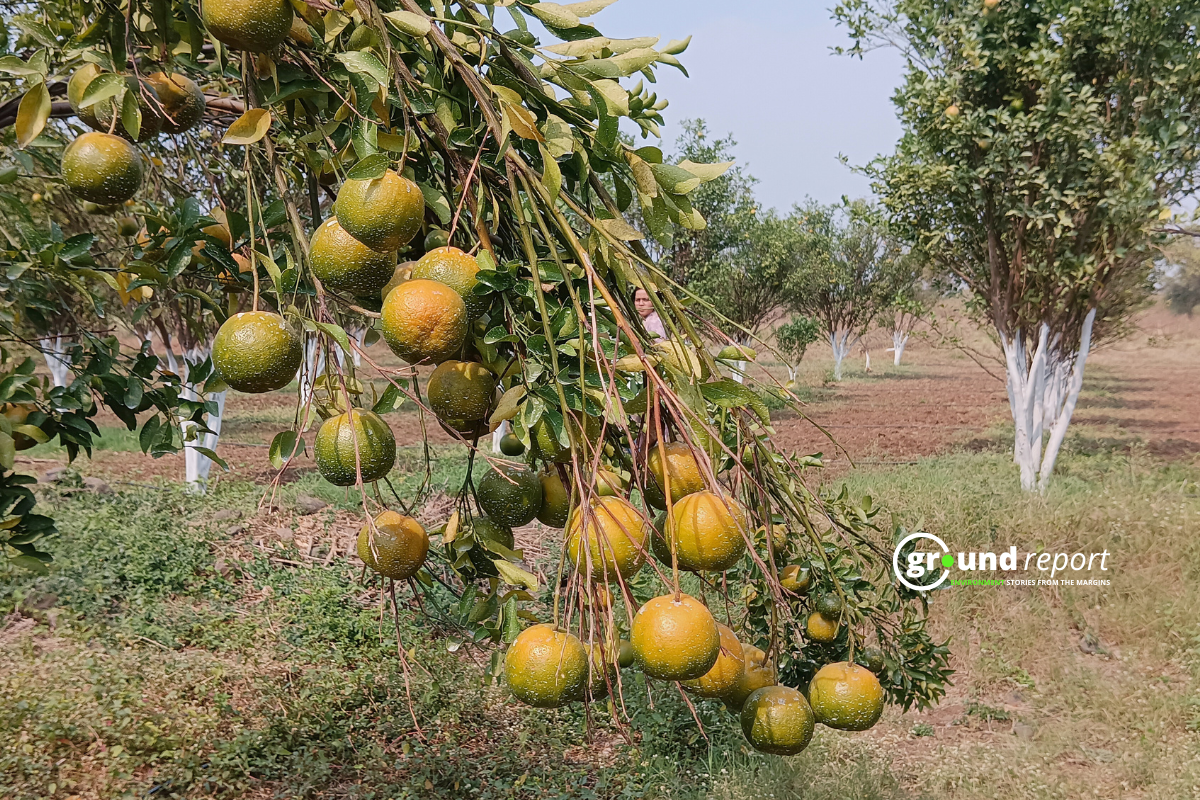
Weather damages oranges
Chatakwar, who also cultivates cotton on his two-acre farm, had invested his earnings from cotton into his orange orchard, expecting a bountiful harvest. However, the sudden rainstorm devastated his crop, pushing him to the brink of despair.
Overcome with hopelessness, he jumped into the well on his farm. Fortunately, his friends working in nearby fields saw him in time and pulled him out. Reflecting on the loss, Chatakwar says,
“It has set us back five years. With the burden of loans, we can’t even afford our children’s school fees.”
There are 6 members in Chatakwar’s family. Talking about his annual family income, he says,
“Two to three lakh rupees are earned in a year, but if such a disaster strikes, it is not even 50 thousand.”
The Forty-year-old farmer received ₹40,000 as compensation from the government—the highest amount he has ever received. He shares that if he had known the government would provide adequate support, he would not have considered taking his own life.
Despite receiving compensation, orange farmers like Chatakwar continue to struggle. Unpredictable weather has once again impacted his crop this year. He says production has dropped to half of last year’s yield. According to him, two factors are responsible: first, the Ambiya Bahar blossoms were lost in last year’s storm, and second, he believes the storm weakened the trees’ roots, affecting overall production.
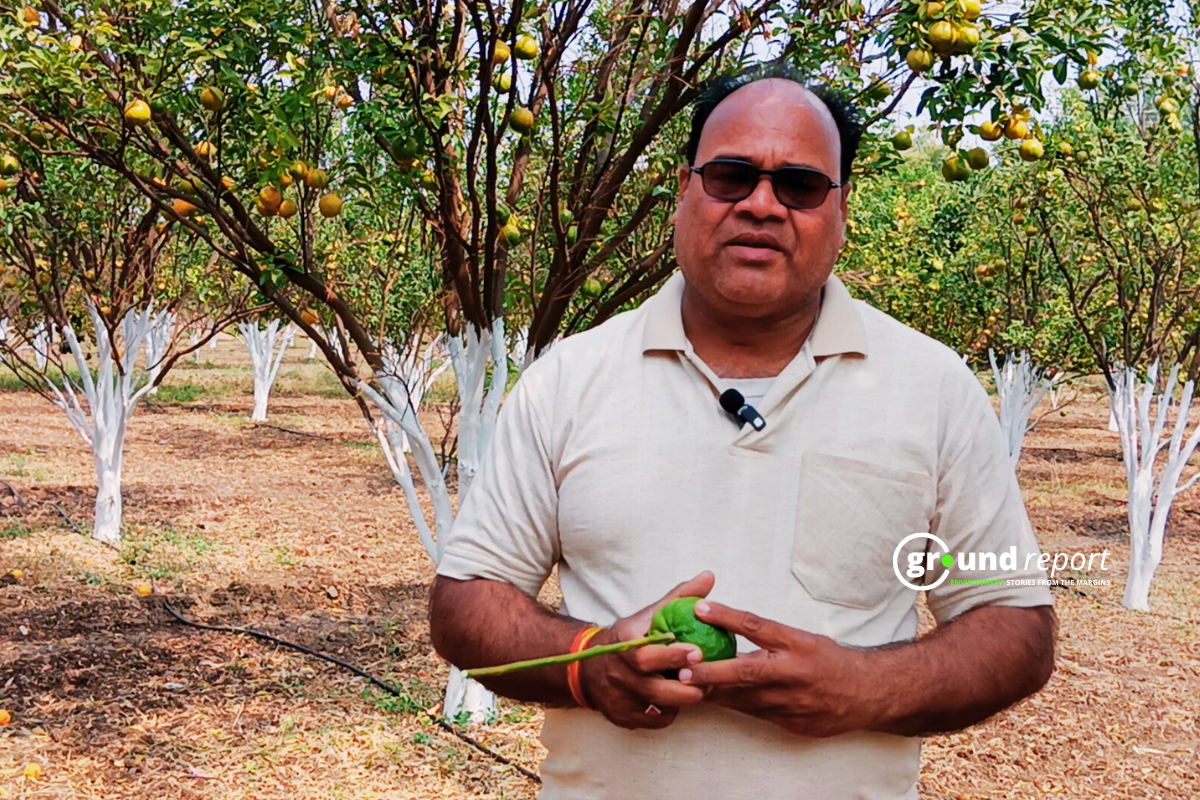
Last year, the orange crop in Pandhurna and Saunsar was badly affected by the weather, first in March and then again in April. However, this did not impact the overall annual production of the Chhindwara district. Data from the last five years (2019-2024) shows that both orange production and the farming area increased from 2019 to 2021. Even though reports of crop damage were published in the media in 2020 and again in 2024, the district’s overall production and farming area have remained stable.
Siddharth Dopare, Senior Horticulture Development Officer in charge of Pandhurna district, says that the farmers here traditionally used to take the crop of Mrig Bahar mainly. This crop is completely dependent on the weather. However, due to the irregularity of the weather, farmers are now shifting to Ambiya Bahar. He gives the example of last year,
“A gap of 15 days in irrigation is necessary to keep the ratio of carbon and nitrogen in the soil correct. But last year due to continuous rain, there was moisture in the soil which is not right for Mrig Bahar.”
He says that if the soil does not get air and sunlight, the risk of fungal infection on the tree increases. He says that gummosis disease has increased in oranges in the last few years. Dopare says that due to seasonal irregularities, orange production has been affected by 10 to 20%.
Trade disrupted
The changing weather has significantly impacted orange traders. Dinesh Kolhe, a local trader, describes the business as unpredictable, saying,
“The orange trade is risky because nothing is certain.”
Previously, Pandhurna had around 102 to 105 private orange mandis, but now only 15 remain. Kolhe explains that due to erratic weather and declining production, many traders struggled to find buyers, ultimately forcing them out of business.
Explaining the orange trade, Kolhe says that after the flowers bloom and about four months before the fruit ripens, traders inspect the orchard and set a price for the entire harvest based on the estimated yield. The agreed amount is then paid to the farmer in installments before the main crop is harvested.
Similarly, Kolhe struck a deal with a farmer last year at a rate of 4 rupees per orange, estimating that he would earn 4 lakh rupees from the sale. He made an advance payment of 2 lakh rupees to the farmer. However, in March, a sudden weather change destroyed half of the oranges in the orchard, resulting in a 2 lakh rupee loss. Kolhe mentions that this has been a recurring issue for many traders over the past decade, leading to the closure of his market.
Vinod Jumde of Tigaon is both a farmer and trader of oranges. He also says that if the production is less due to weather, then the trader has to bear the loss. He says,
“If you have made a deal of Rs 5 lakh with the farmer, then you have taken a risk. Now even if the crop gets destroyed, you have to pay this money.”
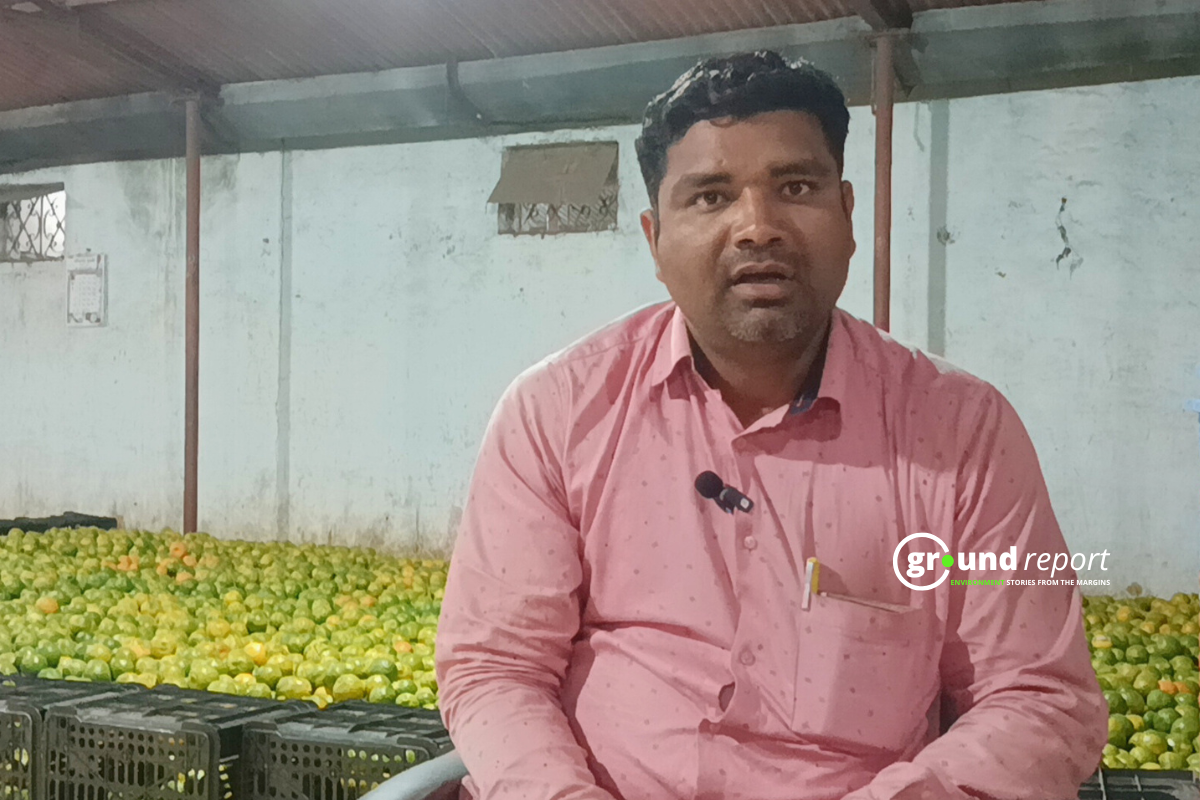
However, Dinesh says that when the trader suffers a big loss, then to maintain the relationship, the farmer leaves some money from the deal so that the loss can be compensated.
Jumde says that earlier, oranges from Pandhurna were sent to Delhi by train, and from there, they were distributed across the country. But now, since the railway has stopped this service, traders have to spend more on transportation. He explains that if a trader has a higher production, it becomes easier to manage these extra costs.
Manohar Chatakwar says that even though his crop has decreased this time, he is most worried about the irregular weather. He says that due to irregular rainfall, the risk of fungus increases, so he has to use more pesticides. Where he used to spray twice, now he has to do it six to seven times.
Talking to the farmers of Pandhurna, it becomes clear that irregular weather has made things harder for them. This region of Madhya Pradesh is close to Vidarbha in Maharashtra, an area often in the news for farmer suicides and crop damage. While government data shows that Chhindwara’s overall production remains stable, the struggles of farmers like Manohar Chatakwar remind us that real losses go beyond just numbers.
Support us to keep independent environmental journalism alive in India.
Keep Reading
Mission aatmanirbharta in pulses: MP farmers remain skeptical
On Ground: Plastic mulching boosts yield but harms soil health
Chhindwara’s maize-ethanol dream: promise vs reality
Erosion ravages Chambal: puts farmers, biodiversity at risk
Follow Ground Report on X, Instagram and Facebook for environmental and underreported stories from the margins. Give us feedback on our email id greport2018@gmail.com.
Don’t forget to Subscribe to our weekly newsletter, Join our community on WhatsApp, and Follow our YouTube Channel for video stories

